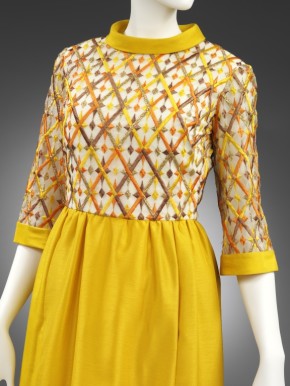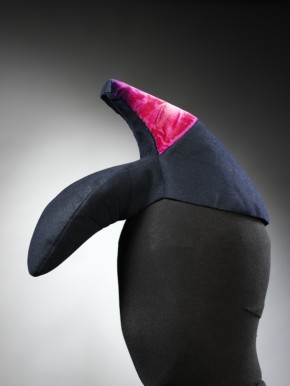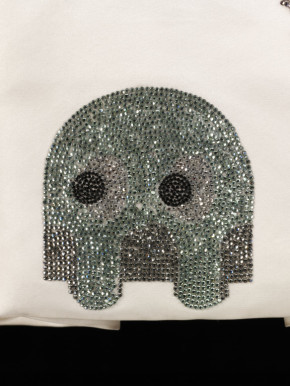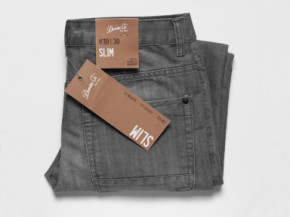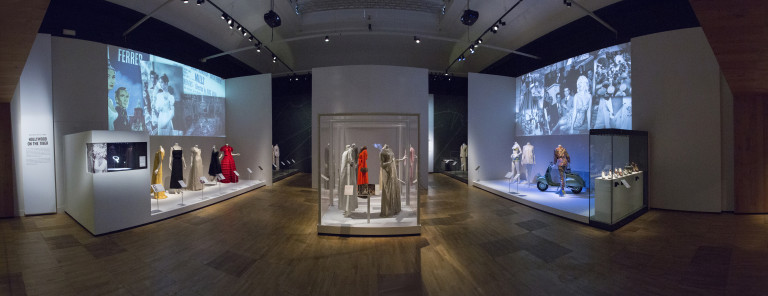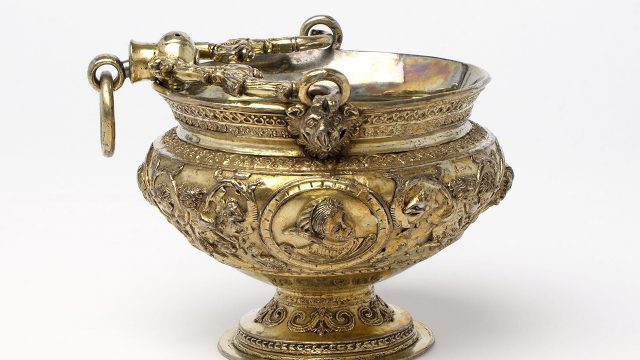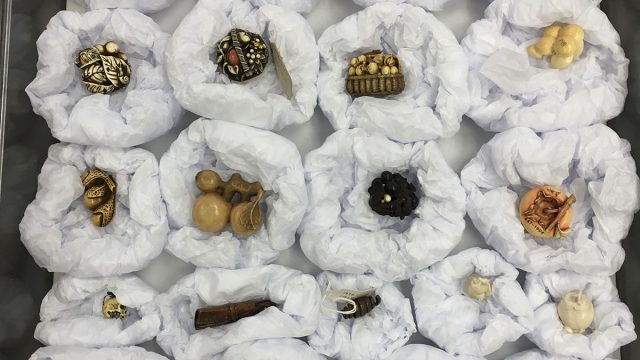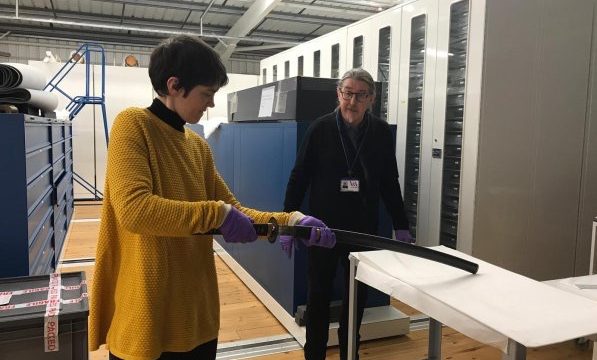What do Chanel’s interlocking ‘C’s, Louboutin’s red sole and David Bowie’s stage costumes have in common? They are all protected by intellectual property (IP). 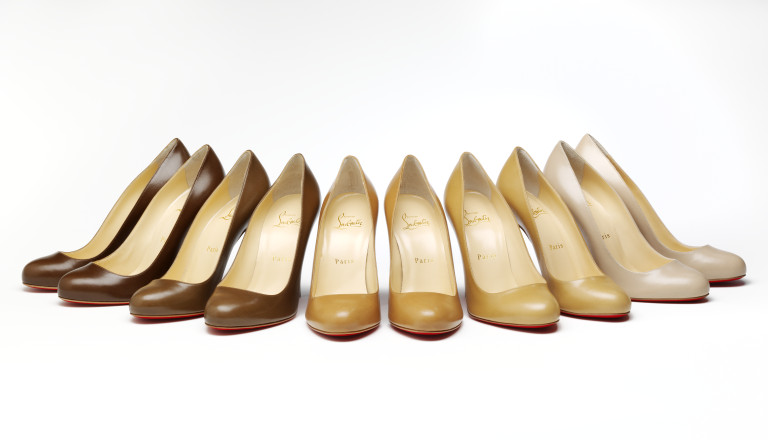
5 pairs of Christian Louboutin Fifi pumps with 100mm heel in shade Blush No. 5. Museum no. CD.28-2014- CD.32-2014 ©Victoria and Albert Museum,London
What is IP I hear you ask (or sigh) and why do you need to know about it? IP is like physical property. It can be sold, bought, inherited or otherwise transferred. It is a valuable asset and whether you are a creator, consumer or custodian of someone else’s work, it is important to understand your rights and respect the rights of others. Copyright and Trademarks are examples of IP.
For a cultural heritage organisation who may be creators, owners, users, managers and providers of content, IP can become a potential minefield as well as its greatest asset. Add to this transitions in IP legislation, expectations to make more content available for free, anonymous works, institutional financial and operational challenges and it is tempting to hide in box of fashion plates.
As the Victoria and Albert Museum’s (V&A) Intellectual Property Manager, it might seem an injustice to describe IP as our collection’s ‘grey areas’. We hold an eclectic collection ranging from artistic works such as photographs, drawings and prints to manufactured consumer products and iconic fashion pieces and the IP enquiries keep me on my toes.
I provide ‘best practice’ IP advice and work collaboratively across the Museum and externally to ensure that colleagues are risk aware but understand that IP is an enabler to access rather than a barrier. It just needs to be understood and managed pragmatically. We strive to achieve this by developing key IP policies, procedures, guidelines and training that works for our organisation and collections. As the V&A holds a wonderful collection of fashion, we are often faced with unraveling the IP conundrums surrounding ownership, permissions and what is protected by IP where there is largely speaking little guidance out there for those managing fashion collections.
Has this dress been mass produced?
This ready-to-wear dress was worn by Princess Anne and bought from the Bellville Sassoon boutique.
Evening dress of synthetic fabric and embroidered organdie, designed by Belinda Bellville and David Sassoon for Bellville Sassoon, London, 1968. Museum no. T.54-1974 ©Victoria and Albert Museum,London/Belinda Bellville and David Sassoon for Bellville Sassoon
Did the creator intend this hat to be a work of art?
Oneof the best known of the surrealist pieces made in collaboration with the artist Salvador Dali. Hat in the shape of a shoe, Schiaparelli, 1937-38, France. Museum no. T.2-1999 ©Victoria and Albert Museum, London/Elsa Schiaparelli
What was the agreement made between the three designers who collaborated on this range of textiles? Do we need to seek permission from both creators of this work? The list goes on.
So why is there no clear guidance for those managing other people’s fashion creations? This may be due in part to the subjective nature of fashion. As a cultural heritage organisation, we may acquire fashion garments as expressions of art as well as any social and cultural considerations. Legally fashion has been seen in the UK as serving purely functional purposes, whilst the law varies in other parts of Europe. An expression of art or created primarily for commercial intent?
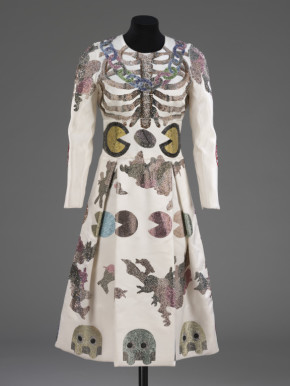
Dress, silk with Swarovski crystal Pac-man motifs, designed by Giles Deacon, England, S/S 2009. Museum no.T-19-2010 ©Victoria and Albert Museum, London/Giles Deacon
The polychrome Swarovski crystal detailling on this Giles Deacon dress reinforces the aesthetic value fashion holds within the V&A’s collections. ©Victoria and Albert Museum,London/Giles Deacon
In the absence of authoritative legislation, I firmly believe that whilst it is important to understand the legal principles success hinges on being able to apply law in practice. For example, what is the real risk? was the anonymous work created with any commercial intent?
Pair of jeans, W:30, L:30 Slim; grey denim; Made by Denim Co; Museum no. PROV.48-2014 ©Victoria and Albert Museum,London
This mass produced pair of jeans reinforce the utilitarian role of fashion which is a driver for deciding how fashion is protected by intellectual property.
For day to day management of our collections, we have seen a shift from curating and providing access to fashion soley in a physical space, to exploring new and innovative ways to reach audiences virtually. The recent groundbreaking shows David Bowie is, The Glamour of Italian Fashion and the forthcoming AlexanderMcqueen: Savage Beauty reinforce the importance and value in seeking permission for using fashion content both on site and online. By working collaboratively with creators and designers you can achieve the best outcome for public access and enjoyment.
The wonderful audiovisual content in the recent Glamour of Italian Fashion exhibition involved securing permission with a number of creators for each individual clip. ©Victoria and Albert Museum,London
The V&A is delighted to be one of 22 partners of the Europeana Fashion project, a 3 year project which aims to provide online access to over 700,000 items of outstanding fashion content from Europe’s leading museums and private fashion archives. It is a unique opportunity to showcase European fashion collectively in a digital space and share an important part of European Cultural Heritage. Please click here for further information about the project.
We are providing over 8000 images of fashion related works and have written ‘best practice’ IP guidelines to support partners when selecting content to make available online. These have been developed with project partners and are based on our experiences in managing fashion content (including 2d and multimedia works). They combine key IP principles with ‘best practice’ flowcharts and useful documents to use when seeking permission. The guidelines have been designed principally to address the challenges facing cultural institutions when managing rights in fashion content. However they also provide a good pragmatic approach to managing rights more generally. Please click here to source the guidelines.
Fashion is as important as any other creative process; whether you protect your work to establish a distinctive brand identity like Chanel or commission emerging designers to create an iconic wardrobe like Bowie’s, cultural institutions have a responsibility to pursue best practice, give credit where credit is due and educate others in a virtual world. Getting it right at the start of any project will ensure that the long-term ambitions to engage with audiences both on site and virtually are achieved.
Disclaimer: These guidelines do not constitute legal advice and simplify a complex subject. However I hope they go some way to reassuring you that by combining a little bit of law, logic and experience, you are on your way to getting it right!

